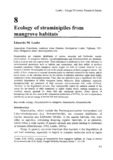Ecology of straminipiles from mangrove habitats
Share
Abstract
Straminipiles are common inhabitants of marine, estuarine and freshwater aquatic environments. In mangrove habitats, halophytophthorans and thraustochytrids are abundant, both in tropical and sub-tropical areas. Their abundance is attributed to their wide tolerance to environmental parameters such as salinity and temperature, and their ability to produce abundant zoospores. Fallen mangrove leaves supply the bulk of organic material in any mangrove habitat. Straminipiles are one of the initial colonizers of fallen mangrove leaves. The ability of their zoospores to respond chemotactically to nutrients released by the leaves, and to attach firmly on the substrata surface by the release of adhesive materials, make them highly competitive in the colonization process. Thus, they are reported to play significant role in the microbial degradation of fallen mangrove leaves. Moreover, these organisms, especially thraustochytrids, are producers of high amounts polyunsaturated fatty acids (PUFAs). Therefore in the degradation process, they consequently enrich the nutrient content of the leaves for the benefit of other organisms at higher trophic levels, making mangroves an excellent nursery grounds for many fish and crustacean species. Some species of thraustochytrids are also used in the commercial production of PUFAs, for use in aquaculture specifically in larval rearing of marine fish and crustaceans.
Suggested Citation
Leaño, E. M. (2002). Ecology of straminipiles from mangrove habitats. In K. D. Hyde (Ed.), Fungi in Marine Environments (pp. 111–134). Hong Kong: Fungal Diversity Press.



